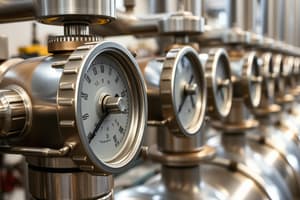Podcast
Questions and Answers
What is the formula for the longitudinal stress (σL) in a cylindrical vessel?
What is the formula for the longitudinal stress (σL) in a cylindrical vessel?
- σL = pD / 2t
- σL = pD / t
- σL = pD / 8t
- σL = pD / 4t (correct)
What is the relationship between the longitudinal stress (σL) and circumferential stress (σt) in a thin-walled pressure vessel?
What is the relationship between the longitudinal stress (σL) and circumferential stress (σt) in a thin-walled pressure vessel?
- σt = σL
- σt = σL / 4
- σt = 2σL (correct)
- σt = σL / 2
What is the total force experienced by the wall in the longitudinal direction in a cylindrical vessel?
What is the total force experienced by the wall in the longitudinal direction in a cylindrical vessel?
- PT = pDL / 2
- PT = pA (correct)
- PT = pDL
- PT = pDL / 4
What is the strength requirement for longitudinal joints compared to girth joints?
What is the strength requirement for longitudinal joints compared to girth joints?
What is the formula for the circumferential stress (σt) in a cylindrical vessel?
What is the formula for the circumferential stress (σt) in a cylindrical vessel?
What is the mode of failure in a thin-walled pressure vessel subjected to excessive gas pressure?
What is the mode of failure in a thin-walled pressure vessel subjected to excessive gas pressure?
What is the primary reason for using semispherical end caps in cylindrical pressure vessels?
What is the primary reason for using semispherical end caps in cylindrical pressure vessels?
A cylindrical pressure vessel is subjected to an internal pressure of 3.5 MPa. If the stress is limited to 140 MPa, what is the maximum internal pressure allowed?
A cylindrical pressure vessel is subjected to an internal pressure of 3.5 MPa. If the stress is limited to 140 MPa, what is the maximum internal pressure allowed?
What is the unit weight of water at standard temperature in the SI system?
What is the unit weight of water at standard temperature in the SI system?
A water tank 5 m in diameter and 8 m high is completely filled. What is the minimum thickness of the tank if the plate stress is limited to 40 MPa?
A water tank 5 m in diameter and 8 m high is completely filled. What is the minimum thickness of the tank if the plate stress is limited to 40 MPa?
A vertical cylindrical steel tank 3 m in diameter and 6 m high has a wall thickness of 12 mm. What is the circumferential stress if the tank is filled with water?
A vertical cylindrical steel tank 3 m in diameter and 6 m high has a wall thickness of 12 mm. What is the circumferential stress if the tank is filled with water?
What is the primary factor affecting the longitudinal stress in a cylindrical pressure vessel?
What is the primary factor affecting the longitudinal stress in a cylindrical pressure vessel?
What is the maximum internal pressure that a tank can withstand if the permissible stress is limited to 5 MPa?
What is the maximum internal pressure that a tank can withstand if the permissible stress is limited to 5 MPa?
What is the minimum required thickness of a boiler plate if the internal pressure is 2 MPa and the permissible tensile stress is 120 MPa?
What is the minimum required thickness of a boiler plate if the internal pressure is 2 MPa and the permissible tensile stress is 120 MPa?
What is the maximum diameter of a boiler if the efficiency of the longitudinal joint is 90% and that of the circumferential joint is 40%?
What is the maximum diameter of a boiler if the efficiency of the longitudinal joint is 90% and that of the circumferential joint is 40%?
What is the minimum number of bolts required to hold a cap on a pipe if the allowable stress in the bolts is 92 MPa and the initial stress is 60 MPa?
What is the minimum number of bolts required to hold a cap on a pipe if the allowable stress in the bolts is 92 MPa and the initial stress is 60 MPa?
What is the primary factor that determines the maximum height of water in a tank if the stress is limited to 5 MPa?
What is the primary factor that determines the maximum height of water in a tank if the stress is limited to 5 MPa?
What is the purpose of a gasket in a pipe flange?
What is the purpose of a gasket in a pipe flange?
Flashcards are hidden until you start studying
Study Notes
Thin-Walled Pressure Vessels
- Cylindrical pressure vessels have semispherical end caps to reduce stress in the tank.
Calculating Stress in Thin-Walled Pressure Vessels
- Tangential stress (Hoop stress) formula: σt = pD / (2t)
- Longitudinal stress (Meridional stress) formula: σL = pD / (4t)
Sample Problems
Problem 2.3.1
- Cylindrical steel pressure vessel with diameter 500 mm, wall thickness 20 mm, and internal pressure 3.5 MPa
- Calculate tangential and longitudinal stress in the cylinder
- Calculate maximum internal pressure to limit stress to 140 MPa
Problem 2.3.2
- Water tank with diameter 5 m, height 8 m, and plate stress limited to 40 MPa
- Calculate minimum thickness of the tank
Problem 2.3.3
- Vertical cylindrical steel tank with diameter 3 m, height 6 m, and wall thickness 12 mm
- Calculate circumferential stress when filled with water
- Calculate longitudinal stress when filled with water
Unit Weight of Water
- Approximately 9810 N/m³ or 9.81 kN/m³ at standard temperature (4°C)
Rupture of Thin-Walled Pipes
- Pipe rupture occurs in the circumferential or hoop direction due to excessive gas pressure
- Formula: σt = 2σL
Studying That Suits You
Use AI to generate personalized quizzes and flashcards to suit your learning preferences.





